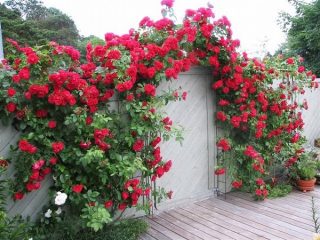Content
The magic and sophistication of garden flowering reaches its apogee when the time of peonies comes. And among the many different varieties, one of the most impressive and delightful is the Camellia peony, which is available in two colors: Camellia White (Camellia White) - white, Camellia Red (Camellia Red) - red. This variety has a unique beauty and grace that can turn any garden into a real paradise of flowers.
Where and how did it appear
Peony Camellia is the result of many years of breeding work. This variety was created in the United States of America. The author of the breeding works is a gardener from an outstanding family of American breeders, Roy Clem. The year of creation of the variety is 1978.
Characteristics and description of Camellia peony
Family | Peony |
Form | Densely double, crowned, rose-shaped |
Genus | Herbaceous interspecific hybrids |
View | Lactofloral |
The leaves of the Camellia peony are large and glossy. They are dark green in color and create a bushy bush that gives the plant an elegant appearance.The stems of this variety are strong and erect.

The bush is well leafed, the plates are large, beautiful openwork shape
Peony flowers are its main highlight. They are large terry buds. Camellia White is white in color with a yellow and sometimes pinkish glow inside. Camellia Red, in turn, is distinguished by its bright red color. They do not have pistils or stamens. The flowers have a harmonious spherical shape and emit a delicate aroma that is pleasant to the senses.
The height and size of the Camellia peony bush can vary, but usually it reaches a diameter of about 60 cm, and stretches upward by 70-80 cm. The spreading shape of the bush gives it elegance and allows you to create attractive garden compositions.

The average duration of budding is a month; flowers in a bouquet last about a week
The Camellia variety belongs to the group of large-flowered and double peonies. Its flowers are large in size and bright. They have many layers of petals that create a dramatic and lush appearance.
Regarding growing conditions, the plant prefers sunny or semi-shaded places. It can be grown in either sun or partial shade, but it is important to provide it with sufficient light for full growth and flowering. The Camellia peony bush is also shade tolerant, making it suitable for growing in gardens with partial shade.
Timing and flowering period
Peonies of this variety bloom in late spring or early summer, usually in May or June. The flowering period can last about two weeks.
For example, in colder climates, flowering may begin later, while in warmer climates, it may occur earlier.
Advantages and disadvantages
Peony Camellia is characterized by the presence of many positive qualities. In addition to its bright appearance, this variety is highly resistant to diseases and pests.

Thanks to the strong, erect stems, the plant does not droop or bend even in unfavorable weather conditions
Pros:
- beautiful densely double inflorescences;
- delicate and pleasant aroma;
- unpretentiousness;
- suitable for cutting.
Minuses:
- sensitivity to diseases and the need for their prevention;
- Regular feeding is required.
Landing Features
Peony Camellia prefers sunny or semi-shaded places. When planting, you must choose a well-lit area with fertile, well-drained, loose soil. Before planting, it is recommended to prepare the soil by adding compost or humus. Peony bushes should be planted 5-7cm deep and spaced about 60cm apart to give them enough room to grow.

Peony Camellia blooms 1-2 years after planting, but shows full terry only 3-4 years
The protective layer will retain moisture on the soil surface and stop the growth of weeds that can choke development.
How to care
The perennial requires regular care for best growth and flowering results. It is important to keep the soil moist, especially during budding and in dry weather. It is also necessary to remove weeds and loosen the soil around the bush. At the end of the season, it is recommended to prune faded flowers and stems.
The plant should be fed in early spring and after flowering with fertilizers rich in organic matter.
Use fertilizers specifically designed for peonies or universal products for flowering plants.
Preparing for winter
The Camellia variety has average resistance to cold, so adult bushes are not covered for the winter (up to a temperature of -40 ° C).
At the end of autumn, you need to remove wilted stems and leaves. It is also recommended to root the soil around the bush with a layer of mulch or dry leaves to protect the roots from frost.
How does it reproduce
Camellia peony can reproduce in such ways as dividing the rhizome of the mother bush and rooting stem cuttings. The most common and easier way is to divide the bush. To do this, you need to dig it up and divide it into several parts, each of which must have roots and buds. Divided bushes can be immediately planted in new places.
Disease and pest control
Camellia peony is usually resistant to diseases and pests. Sometimes it can be attacked by powdery mildew, rust or gray rot. To prevent these problems, it is recommended to ensure good air circulation around the bush and avoid waterlogging of the soil.
Peonies can also be attacked by various pests, such as aphids, ants and mites. They can be controlled using insecticides or mechanical methods such as manually removing the pests or using a jet of water to wash away the insects.
It is important to remember that disease and pest prevention is a key aspect of pest control. Inspecting your plants regularly, maintaining good garden hygiene and ensuring optimal growing conditions will help reduce the risk of problems.If necessary, use appropriate preparations to protect the plant (for example, Khom, Oksikhom, soap or copper solution, etc.).
Application in landscape

This culture goes well with most flowers and plants
Peony can be used in compositions with flowers such as irises, roses, lavender, hostas, mantle, fern or with members of the Peony family of other colors.
Peony Camellia is often used in the landscape design of personal plots, courtyards, city parks and alleys.

The perennial can serve as a decoration for the area in front of the house and fits into mixborders, borders, and front gardens
Peonies can also be grown in flowerpots or containers, making them an excellent choice for balconies and loggias.
Conclusion
Peony Camellia (White, Red) is a beautiful variety of peony that has beautiful flowers and a memorable appearance. A plant with rich red or white buds that exude a wonderful aroma will attract admiring glances. It requires some care, but with suitable growing conditions, it will become a real decoration of any garden.
Reviews from gardeners about Camellia peony








